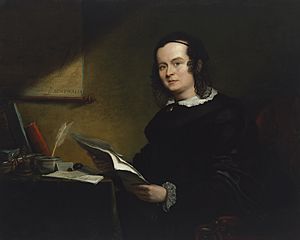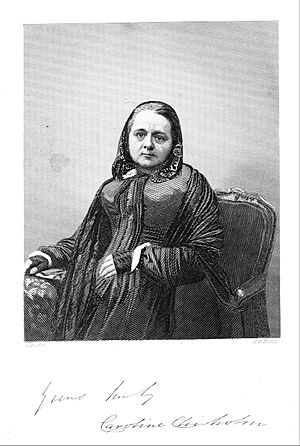Caroline Chisholm facts for kids
Quick facts for kids
Caroline Chisholm
|
|
|---|---|

Caroline Chisholm, 1852, by Angelo Collen Hayter
|
|
| Born |
Caroline Jones
30 May 1808 Northampton, England
|
| Died | 25 March 1877 (aged 68) Highgate, London, England
|
| Occupation | Humanitarian work |
| Known for | Humanitarian work, immigration reform |
| Spouse(s) | Archibald Chisholm |
| Children | 8 children (including Caroline Agnes Gray) |
| Parent(s) | Sarah Jones, William Jones |
Caroline Chisholm (born Caroline Jones; 30 May 1808 – 25 March 1877) was an English humanitarian who lived in the 1800s. She is famous for helping immigrant women and families in Australia. She is remembered on May 16th in the Church of England's calendar of saints. She also began the process to become a saint in the Catholic Church. She became Catholic when she married and raised her children in that faith.
Contents
Caroline Chisholm's Early Life
Caroline Jones was born in 1808 in Northampton, England. She was the youngest of her father's many children. Her father, William Jones, was a pig farmer. He passed away when Caroline was only six years old.
In 1830, when she was 22, Caroline married Archibald Chisholm. He was an officer in the East India Company's army. He was also a Roman Catholic. Caroline became Catholic around this time. They raised their children as Catholics.
Helping People in India
Starting a School in Madras
Caroline's husband returned to Madras, India, in 1832. Caroline joined him there about a year and a half later. She noticed that young girls living with their families in army barracks were learning bad habits from the soldiers.
In 1834, Caroline started a special school for these girls. It was called the Female School of Industry for the Daughters of European Soldiers. The school taught girls useful skills. They learned reading, writing, religion, cooking, housekeeping, and nursing. Soon, soldiers even asked if their wives could attend the school too.
While in India, Caroline and Archibald had two sons. The family moved often as Archibald's army assignments changed.
Caroline Chisholm's Work in Australia
Arriving in Sydney
In 1838, Captain Archibald Chisholm took a break from the army due to poor health. Instead of going back to England, the family decided to move to Australia. They believed the climate there would be better for his health. They sailed to Sydney and arrived in October 1838. The family settled near Windsor.
When visiting Sydney, Caroline and her husband saw how hard life was for new immigrants. They were especially worried about young women arriving alone. These women often had no money, no friends, no family, and no jobs. Caroline started helping these young women. She found them safe places to stay, sometimes even in her own home. She also helped them find permanent places to live and work.
Expanding Her Help for Immigrants
In 1840, Captain Chisholm went back to his army duties in India. But he encouraged Caroline to keep helping people. She opened the first home in Sydney for young women. She also set up other homes in country areas. Soon, her homes helped immigrant families and young men too.
In 1842, Caroline rented two houses in East Maitland. She turned them into one large cottage. This cottage became a hostel for homeless immigrants. These immigrants had traveled to the Hunter Valley looking for work. Today, this building is called Caroline Chisholm Cottage. It is the only building in New South Wales directly linked to her work.
During her seven years in Australia, Caroline helped over 11,000 people find homes and jobs. She became very well-known and respected. She even spoke before government committees. Caroline did her work without taking money from individuals or groups. She wanted to be independent and help everyone, no matter their background or religion. She raised money for her homes through private donations. Her husband returned to Australia in 1845 after leaving the army.
Helping Immigrants from England
Gathering Stories for New Immigrants
Before returning to England in 1846, Caroline and her husband traveled across New South Wales. They collected over 600 stories from immigrants already living there. Caroline believed that the best way to encourage people to move from England to Australia was for them to read letters from those already settled.
In England, the couple published some of these stories in a pamphlet. It was called Comfort for the Poor – Meat Three Times a Day. The famous writer Charles Dickens even used some of these stories in his magazine.
Caroline spoke before government committees in England. She gained support for her ideas. These committees agreed to help pay for wives and children of former convicts to travel to Australia. They also helped children who had been left behind in England.
The Family Colonisation Loan Society
In 1849, Caroline started the Family Colonisation Loan Society. She ran it from her home in London. The Society's goal was to help people move to Australia. It would lend them half the cost of their journey. The immigrants would pay back the loan after living in Australia for two years.
Caroline also held regular meetings at her home. She gave practical advice to people planning to emigrate. The Society first found places on private ships. Later, it rented whole ships for immigrants. Caroline insisted that the ships improve their living conditions. This led to better laws for passenger ships. In 1851, her husband, Archibald, went back to Australia. He helped new migrants and collected loan repayments.
By 1854, the Society had helped more than 3,000 people move to Australia. Caroline gave talks about emigration all over Britain. She also visited France and Italy. She even met Pope Pius IX at the Vatican. He gave her a special medal.
Later Life and Legacy
Return to Australia and Final Years
In 1854, Caroline returned to Australia. She traveled to the Victorian goldfields. She was shocked by the poor conditions for travelers. She suggested building simple shelters about a day's walk apart. This would help gold prospectors and their families travel safely. The government supported her idea.
Caroline continued her work in Melbourne. She later joined her family in Kyneton. Due to her poor health, the family moved back to Sydney in 1858. Her health improved there. In 1859 and 1860, Caroline gave talks about land reform. She wanted land to be set aside for immigrant families to start small farms. She believed this would help new settlers feel more secure.
Caroline died in London, England, on 25 March 1877. Her husband died in August of the same year. They are buried together in Billing Road Cemetery in Northampton.
Caroline Chisholm's Lasting Impact
Caroline Chisholm left a big mark on history:
- A blue plaque in London marks the house where she lived.
- A church in Breadalbane, Australia, is named the Chisholm Memorial Church.
- Many schools and colleges in Australia and England are named after her.
- The suburb of Chisholm in Canberra and a federal voting area are named in her honor.
- The headquarters for Services Australia is named after her.
- Caroline Chisholm has been featured on Australian stamps and banknotes. She was on the $5 note from 1966 to 1995.
- The Caroline Chisholm Society is a charity in Australia. It helps pregnant women and parents with young children.
- The character of Mrs. Jellyby in Charles Dickens's novel Bleak House was partly inspired by Caroline Chisholm.
- A musical about her time in Australia, called Caroline, premiered in 1971.
- The Church of England calendar of saints remembers Caroline Chisholm on May 16th.
Images for kids
-
The Chisholm Memorial Church at Breadalbane
See also







